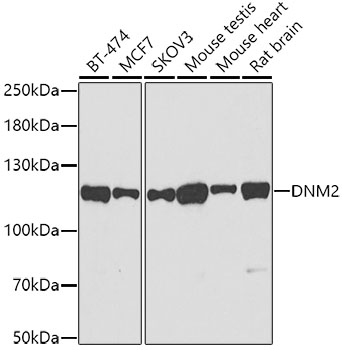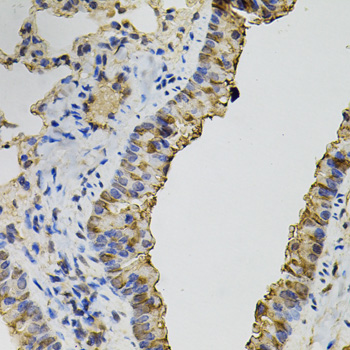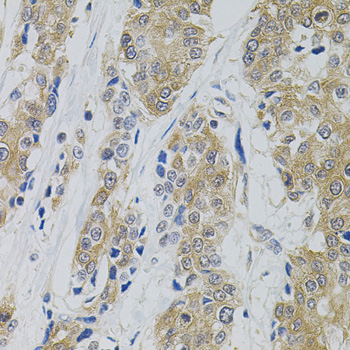Cell Biology Antibodies 1
Anti-DNM2 Antibody (CAB0523)
- SKU:
- CAB0523
- Product Type:
- Antibody
- Reactivity:
- Human
- Reactivity:
- Mouse
- Reactivity:
- Rat
- Host Species:
- Rabbit
- Isotype:
- IgG
- Antibody Type:
- Polyclonal Antibody
- Research Area:
- Cell Biology
Description
| Antibody Name: | Anti-DNM2 Antibody |
| Antibody SKU: | CAB0523 |
| Antibody Size: | 20uL, 50uL, 100uL |
| Application: | WB IHC |
| Reactivity: | Human, Mouse, Rat |
| Host Species: | Rabbit |
| Immunogen: | A synthetic peptide of human DNM2 |
| Application: | WB IHC |
| Recommended Dilution: | WB 1:500 - 1:2000 IHC 1:50 - 1:200 |
| Reactivity: | Human, Mouse, Rat |
| Positive Samples: | BT-474, MCF7, SKOV3, Mouse testis, Mouse heart, Rat brain |
| Immunogen: | A synthetic peptide of human DNM2 |
| Purification Method: | Affinity purification |
| Storage Buffer: | Store at -20'C. Avoid freeze / thaw cycles. Buffer: PBS with 0.02% sodium azide, 50% glycerol, pH7.3. |
| Isotype: | IgG |
| Sequence: | Email for sequence |
| Gene ID: | 1785 |
| Uniprot: | P50570 |
| Cellular Location: | Cell junction, Cytoplasm, Membrane, Midbody, clathrin-coated pit, cytoskeleton, postsynaptic cell membrane, postsynaptic density, synapse |
| Calculated MW: | 97kDa/98kDa |
| Observed MW: | 110kDa |
| Synonyms: | DNM2, CMT2M, CMTDI1, CMTDIB, DI-CMTB, DYN2, DYNII, LCCS5, dynamin-2 |
| Background: | Dynamins represent one of the subfamilies of GTP-binding proteins. These proteins share considerable sequence similarity over the N-terminal portion of the molecule, which contains the GTPase domain. Dynamins are associated with microtubules. They have been implicated in cell processes such as endocytosis and cell motility, and in alterations of the membrane that accompany certain activities such as bone resorption by osteoclasts. Dynamins bind many proteins that bind actin and other cytoskeletal proteins. Dynamins can also self-assemble, a process that stimulates GTPase activity. Five alternatively spliced transcripts encoding different proteins have been described. Additional alternatively spliced transcripts may exist, but their full-length nature has not been determined. |
| UniProt Protein Function: | DYN2: a cytoplasmic microtubule-associated force-producing protein involved in producing microtubule bundles and able to bind and hydrolyze GTP. Most probably involved in vesicular trafficking processes. May mediate the conventional clathrin-mediated uptake of surface receptors. Expressed in the postsynaptic density of neuronal cells. Two alternatively spliced isoforms have been described. |
| UniProt Protein Details: | Protein type:Microtubule-binding; EC 3.6.5.5; Motility/polarity/chemotaxis; Vesicle; Hydrolase Chromosomal Location of Human Ortholog: 19p13.2 Cellular Component: Golgi membrane; Golgi apparatus; postsynaptic membrane; microtubule; growth cone; focal adhesion; postsynaptic density; cytoplasm; plasma membrane; coated pit; midbody; cytosol Molecular Function:GTPase activity; protein binding; enzyme binding; GTP binding; microtubule binding; SH3 domain binding Biological Process: receptor-mediated endocytosis; positive regulation of apoptosis; positive regulation of transcription, DNA-dependent; synaptic vesicle transport; antigen processing and presentation of exogenous peptide antigen via MHC class II; transferrin transport; endocytosis; regulation of axon extension; signal transduction; nitric oxide metabolic process; regulation of transcription, DNA-dependent; receptor internalization; post-Golgi vesicle-mediated transport; regulation of nitric-oxide synthase activity; G2/M transition of mitotic cell cycle; neurite morphogenesis Disease: Lethal Congenital Contracture Syndrome 5; Myopathy, Centronuclear, 1; Charcot-marie-tooth Disease, Dominant Intermediate B |
| NCBI Summary: | Dynamins represent one of the subfamilies of GTP-binding proteins. These proteins share considerable sequence similarity over the N-terminal portion of the molecule, which contains the GTPase domain. Dynamins are associated with microtubules. They have been implicated in cell processes such as endocytosis and cell motility, and in alterations of the membrane that accompany certain activities such as bone resorption by osteoclasts. Dynamins bind many proteins that bind actin and other cytoskeletal proteins. Dynamins can also self-assemble, a process that stimulates GTPase activity. Five alternatively spliced transcripts encoding different proteins have been described. Additional alternatively spliced transcripts may exist, but their full-length nature has not been determined. [provided by RefSeq, Jun 2010] |
| UniProt Code: | P50570 |
| NCBI GenInfo Identifier: | 47117856 |
| NCBI Gene ID: | 1785 |
| NCBI Accession: | P50570.2 |
| UniProt Secondary Accession: | P50570,Q5I0Y0, Q7Z5S3, Q9UPH4, A8K1B6, E7EV30, E9PEQ4 K7ESI9, |
| UniProt Related Accession: | P50570 |
| Molecular Weight: | 870 |
| NCBI Full Name: | Dynamin-2 |
| NCBI Synonym Full Names: | dynamin 2 |
| NCBI Official Symbol: | DNM2 |
| NCBI Official Synonym Symbols: | DYN2; CMT2M; DYNII; LCCS5; CMTDI1; CMTDIB; DI-CMTB |
| NCBI Protein Information: | dynamin-2; dynamin II |
| UniProt Protein Name: | Dynamin-2 |
| Protein Family: | Dynamin |
| UniProt Gene Name: | DNM2 |
| UniProt Entry Name: | DYN2_HUMAN |









